Traveling with your cat in the car should be comfortable and safe for both her and you. This applies to both long journeys and short trips to the country.
How to make sure that everything goes well? And what do you need to prepare for the trip?
Why a car trip is stressful for a cat
Most cats live permanently in an apartment and do not have access to the street. A familiar room is their territory, where our pets feel safe. Everything here is so beloved and familiar – smells, objects, people.
And then you are placed in a carrier, carried out into the street, into the big world, and then put into a nasty growling car. Who would like that? Naturally, the cat will be frightened by such a sudden change of scenery, and such a situation can cause her stress.
What to do
Ideally, you should train your cat to use the car from a very young age. Periodically take short trips with it. If you have an adult cat, then you should do the same with it.
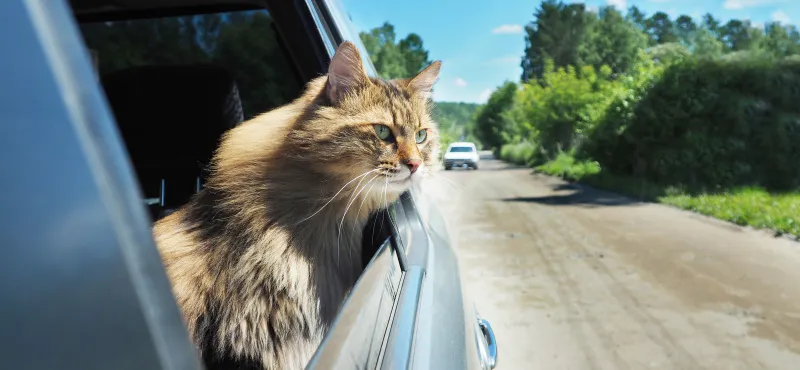
Do not forget that a cat that goes to the country in spring and summer, during the long winter months, gets out of the habit of traveling, so stress can arise in such a situation. Do not forget to periodically take time to spend time together in the vehicle, so that the purr remembers that riding in a car is not scary at all.
About sedatives for cats
If the pet has a hard time tolerating the trip, is nervous, meows loudly, scratches the carrier, then you cannot do without sedatives.
They can be:
1. Medicinal – act as antidepressants.
2. Pheromone-based – such products are usually available in the form of sprays that need to be used to treat the carrier.
3. Vegetable – made on the basis of essential oils and herbs, have a cumulative effect, so it is better to start giving them to the cat in advance.
Importantly! A veterinarian should select a sedative for the cat. There are contraindications, so do not forget to read the instructions.
If the cat gets motion sickness
This condition is indicated by:
- pant;
- open mouth with the tip of the tongue protruding;
- vomit;
- general tension of the pet.
As a rule, a cat gets motion sickness in the car due to stress, so in most cases, the use of the aforementioned sedatives will help. However, there are also physiological reasons associated with the activation of the emetic.
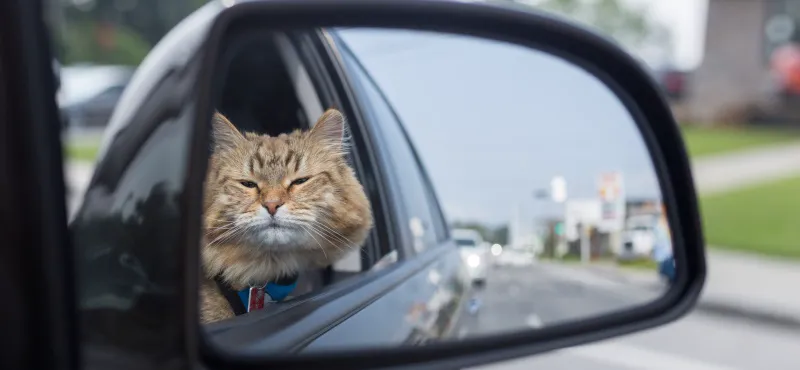
Consult your veterinarian about this. If necessary, he will prescribe drugs for motion sickness.
In order to reduce the risk of “seasickness”:
- Do not feed your pet 3-4 hours before the trip.
- Do not play loud music.
- Make sure that the car is well ventilated.
- Cover the carrier with a towel or set it up so that your cat can’t see the movement of surrounding objects.
What to take with you
In order for the trip to be comfortable and safe for the cat, you should prepare for it in advance.
You will need:
Carrier or lounger on a car seat
The main purpose of these attributes is the safety of the pet.
The carrier protects the four-legged from all sides, preventing injuries. You can choose both plastic and fabric models.
Fabric carrier bags are made of durable materials that are easy to clean and wash. The products are equipped with a good ventilation system and mesh windows for viewing.
Plastic carriers are easy to care for – just wipe the surface with a damp cloth or cloth. They have reliable locks and excellent ventilation.
The carrier should be chosen so that the cat can stand up, lie down, and turn around in it.
Car seat loungers are suitable for purrs who categorically do not want to ride in a carrier. Some models are equipped with a carabiner for fastening the cat to the collar, as well as a mechanism for attaching it to the seat. High sides prevent hair from appearing on the upholstery. The materials are resistant to claws and do not cause allergies.
Important! It is advisable to accustom the cat to the carrier in advance. To do this, 5-7 days before the trip, place the carrier in the room so that the pet can enter it at any time.
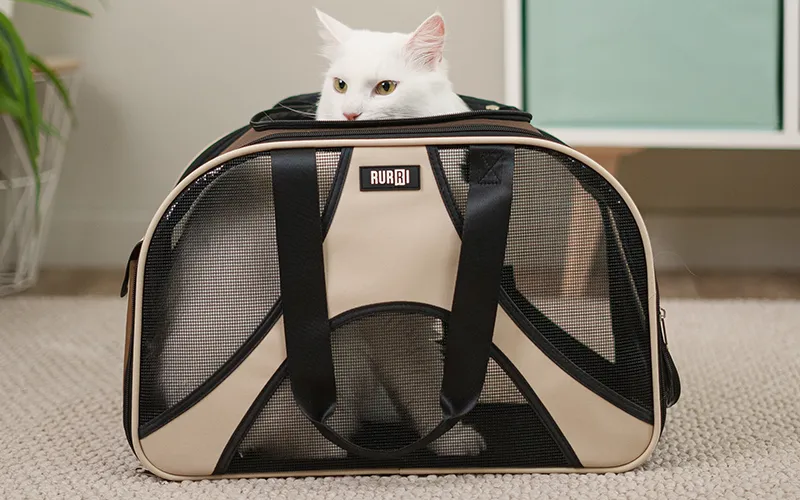
Travel bowls
If the trip is going to be long, it is better to choose the “road” option made of silicone. Small bowls are suitable for both food and water. Easy to clean and fold without taking up much space.
Water bottle
Travel bottles are convenient to take with you: they are compact and equipped with a tray in which you can pour water – this will make it easier for the cat to drink.
Feed
During a long journey, the cat may get hungry, then you need to offer it a meal. Don’t forget to bring her favorite food. It is better to choose a wet one, because it has a pleasant taste and aroma, in addition, it is produced in portions. If your pet prefers food in pellets, you can take a small package and a measuring scoop with you – in order not to make a mistake with the dosage.
Wet wipes for cats
Anything can happen on the road. For example, the purr will get dirty when eating food, and it will be necessary to wipe it. Wet wipes will come in handy for this purpose. It is advisable to choose products designed specifically for cats.
Tray and disposable diapers
On a trip, the cat may want to go to the toilet. Some pets calmly go to the toilet in the litter box right in the car – just make a stop, install a container on the floor and pour a little litter into it. In order to facilitate cleaning, you can use tray bags.
However, most cats prefer not to leave the carrier on the road, so the bottom should be covered with a disposable diaper.
Harness and leash
It will come in handy for long journeys, because the mustachioed pet will need to stretch its paws. Choose comfortable ammunition with a strong carbine to avoid the possibility of escape. Do not forget to accustom the cat to the harness in advance. To do this, start training in wearing ammunition a few weeks before the trip.
Dainty
It is a tasty reward for your pet for good behavior on the road. In addition, eating treats can distract the purr for a while, and if she is very worried, then you will spend a few minutes in silence.
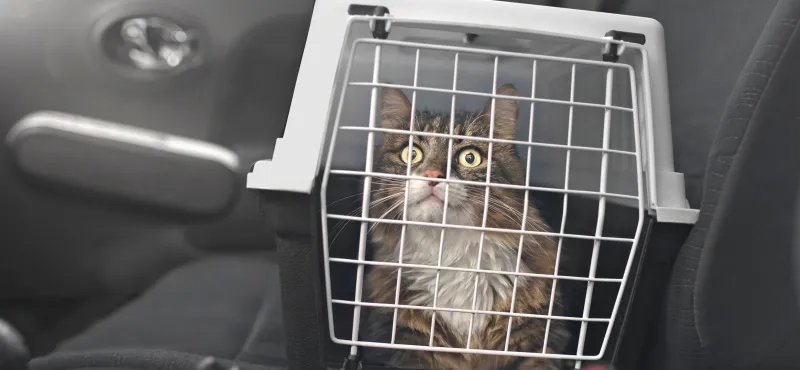
Toy
Be sure to put your cat’s favorite toy in the carrier. It is desirable if it is a textile model that smells like your favorite home and does not make annoying sounds.
First aid kit for a cat
Anything can happen on the road, so prepare a first aid kit with products designed specifically for the cat.
It should include:
1. Antiseptics.
2. Wound healing powders and ointments.
3. Dressings (sterile gauze bandages and napkins).
4. Tools (syringes of different sizes, scissors, tweezers, thermometer, “tick remover”).
5. Prophylactic agents (lotions and napkins for eyes, ears, paws).
6. Potent drugs – antibiotics (given only in emergency cases).
7. Products for the gastrointestinal tract (sorbents, prebiotics).
8. Antihistamines.
9. Antiparasitic drugs (from fleas, ticks, helminths).
Buy these products in veterinary pharmacies, as drugs intended for humans can be dangerous for four-legged animals. Talk to your veterinarian about specific products that will come in handy on the road.
Importantly! If your cat has a health problem, take her to a veterinarian as soon as possible. Remember that self-medication can be dangerous!
Cat Safety Tips in the Car
1. The optimal place for carrying is the back seat. If necessary, you can place her at her feet, but it’s important to make sure she gets the right amount of fresh air.
2. Secure the carrier firmly onto the seat. To do this, you can put it in the middle, and put suitcases, bags, child car seats on the sides.
3. Try not to let the cat walk around the cabin. If you do decide to do this for a few minutes, make sure that all windows and doors are closed and the cat does not interfere with the driver of the car.
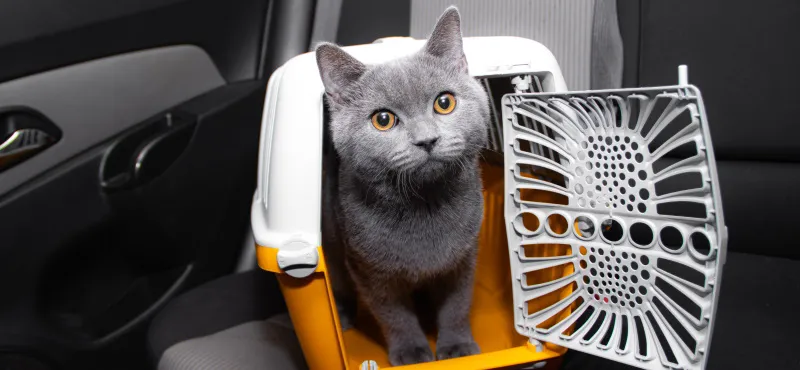
4. Have you decided to take a walk with a cat? Don’t forget about the harness and leash. It is advisable to treat the coat with flea and tick spray before this. After a walk, do not forget to wipe your pet’s paws with special wet wipes.
5. While driving, keep the speed, avoid sharp turns and holes on the road.
6. Try to maintain a comfortable temperature in the cabin.
7. Keep the carrier with your cat in the shade.
8. Do not leave your pet alone in a parked car in the heat.
9. During the trip, talk to the cat in a gentle voice.
Importantly! The main key to a successful trip is the positive emotions of the owner. Pets subtly feel our mood, and your excitement can be transferred to the cat.
Summing up
1. A trip by car should be as comfortable and safe as possible for both the cat and its owner.
2. Any trip can be stressful for the cat, so it is advisable to accustom him to the vehicle from a very young age.
3. If your cat is nervous on the road, ask your veterinarian to find a sedative for her.
4. Some cats get motion sickness in the car. This can be caused by both psychological and physiological reasons. And in this case, you cannot do without the advice of a specialist.
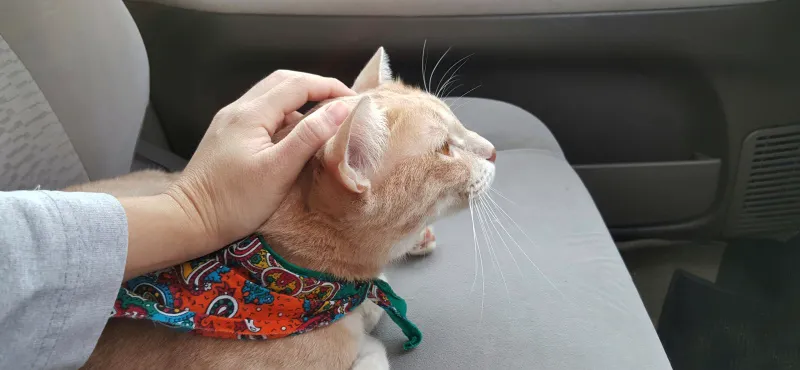
5. Prepare everything you need for your trip. You will need a carrier, bowls, a bottle of water, food, treats, etc.
6. Do not forget to collect a first-aid kit containing products and drugs that may be useful.
7. Make sure that the carrier is firmly fixed in the back seat. Do not let your cat out unless necessary.
8. Follow the traffic rules.
9. Do not leave your pet alone in the heat in the car.
10. Stay calm and positive.
